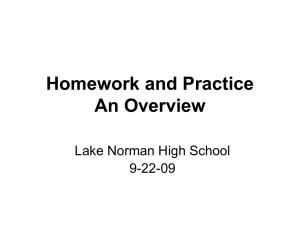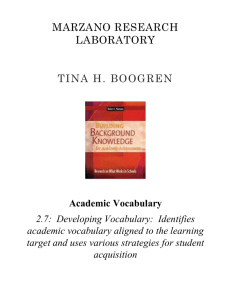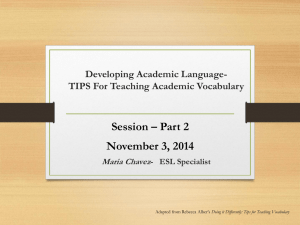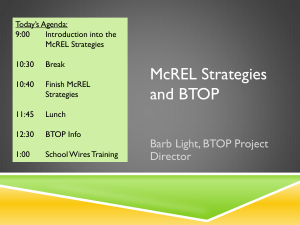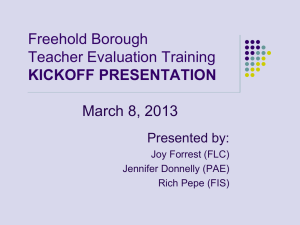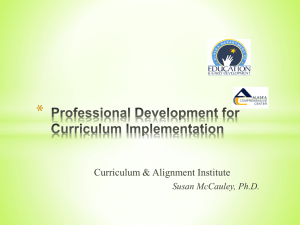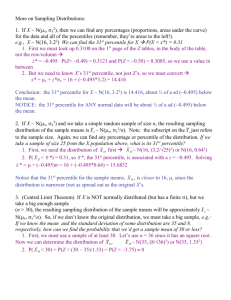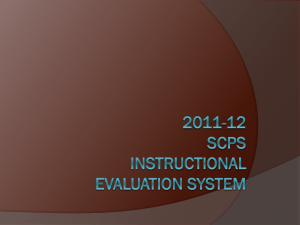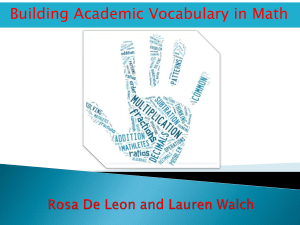Marzano's 10 Design Questions: A Teacher's Guide
advertisement
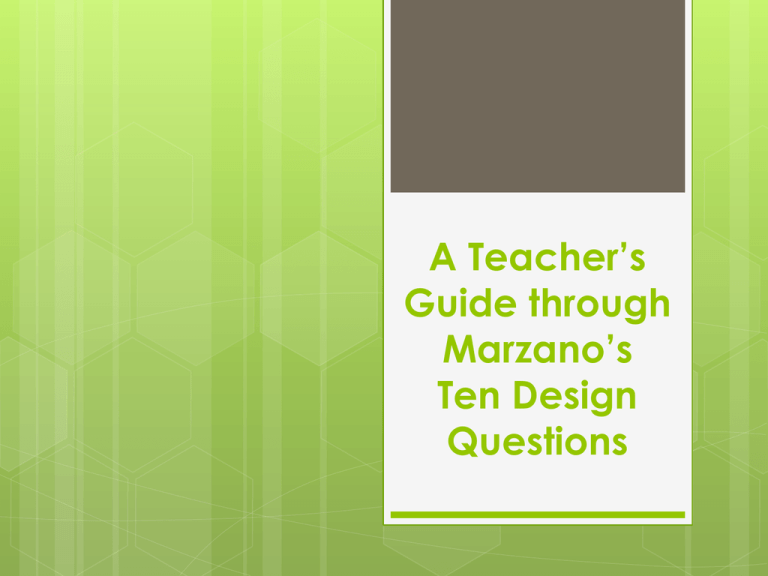
A Teacher’s Guide through Marzano’s Ten Design Questions The Art and Science… Welcome to A Teacher’s Guide through Marzano’s Ten Design Questions This PowerPoint presentation is designed to provide classroom teachers with action steps to master the Art and Science of Teaching. The strategies and research-findings presented are retrieved from The Art and Science of Teaching: A Comprehensive Framework for Effective Instruction by Robert J. Marzano. Effective Teachers = Effective Schools Marzano states “among elements such as a well-articulated curriculum and a safe orderly environment, the one factor that surfaced as the single most influential component of an effective school is the individual teachers within that school” (2007). Effective Teaching Research Research findings by Nye, Konstantopoulos, and Hedges support Marzano’s statement on effective teaching. According to Marzano, the trio’s research study “dramatically answers the question of how much influence the individual classroom teacher has on student achievement” (2007). Nye and colleagues research indicates that students who have a teacher at the 75th percentile in terms of pedagogical competence will outgain students who have a teacher at the 25th percentile by 14 percentile points in reading and 18 percentile points in mathematics. The trio’s research also indicates that students who have a 90th percentile teacher will outgain students who have a 50th percentile teacher by 13 percentile points in reading and 18 percentile points in mathematics. DQ #1: What will I do to establish and communicate learning goals, track student progress, and celebrate success? Action Step #1: Make a Distinction Between Learning Goals and Learning Activities or Assignments Action Step #2: Write a Rubric or Scale for Each Learning Goal Action Step #3: Have Students Identify Their Own Learning Goals Action Step #4: Assess Students Using a Formative Approach Action Step #5: Have Students Chart Their Progress on Each Learning Goal Action Step #6: Recognize and Celebrate Growth DQ #2: What will I do to help students effectively interact with new knowledge? Action Step #1: Identify Critical-Input Experiences Action Step #2: Preview the Content Prior to a Critical-Input Experience Action Step #3: Organize Students into Groups to Enhance the Active Processing of Information Action Step #4: Present New Information in Small Chunks and Ask for Descriptions, Discussions, and Predictions Action Step #5: Ask Questions That Require Students to Elaborate on Information Action Step #6: Have Students Write Out Their Conclusions or Represent Their Learning Nonlinguistically Action Step #7: Have Students Reflect on Their Learning DQ #3: What will I do to help students practice and deepen their understanding of new knowledge? Action Step #1: Provide Students with Tasks that Require Them to Examine Similarities and Differences Action Step #2: Help Students Identify Errors in Thinking Action Step #3: Provide Opportunities for Students to Practice Skills, Strategies, and Processes Action Step #4: Determine the Extent to Which Cooperative Groups Will Be Used Action Step #5: Assign Purposeful Homework That Involves Appropriate Participation from the Home Action Step #6: Have Students Systematically Revise and Make Corrections in Their Academic Notebooks DQ#4: What will I do to help students generate and test hypothesis about new knowledge? Action Step #1: Teach Students About Effective Support Action Step #2: Engage Students in Experimental Inquiry Tasks That Require Them to Generate and Test Hypothesis Action Step #3: Engage Students in Problem-Solving Tasks That Require Them to Generate and Test Hypothesis Action Step #4: Engage Students in Decision-Making Tasks that Require Them to Generate and Test Hypothesis Action Step #5: Engage Students in Investigation Tasks that Require Them to Generate and Test Hypothesis Action Step #6: Have Students Design Their Own Tasks Action Step #7: Consider the Extent to Which Cooperative Learning Structures Will Be Used DQ #5: What will I do to engage students? Action Step #1: Use Games That Focus on Academic Content Action Step #2: Use Inconsequential Competition Action Step #3: Manage Questions and Response Rates Action Step #4: Use Physical Movement Action Step #5: Use Appropriate Pacing Action Step #6: Demonstrate Intensity and Enthusiasm for Content Action Step #7: Engage Students in Friendly Controversy Action Step #8: Provide Opportunities for Students to Talk About Themselves Action Step #9: Provide Unusual Information DQ #6: What will I do to establish or maintain classroom rules and procedures? Action Step #1: Organize the Classroom Effective Teaching and Learning Action Step #2: Establish a Small Set of Rules and Procedures Action Step #3: Interact with Students About Classroom Rules and Procedures Action Step #4: Periodically Review Rules and Procedures, Making Changes as Necessary Action Step #5: Use Classroom Meetings DQ #7: What will I do to recognize and acknowledge adherence and lack of adherence to classroom rules and procedures? Action Step #1: Use Simple Verbal and Nonverbal Acknowledgement Action Step #2: Use Tangible Recognition When Appropriate Action Step #3: Involve the Home in Recognition of Positive Student Behavior Action Step #4: Be With-It Action Step #5: Use Direct-Cost Consequences Action Step #6: Use Group Contingency Action Step #7: Use Home Contingency Action Step #8: Have a Strategy for High-Intensity Situations Action Step #9: Design an overall Plan for Disciplinary Problems DQ #8: What will I do to establish and maintain effective relationships with students? Action Step #1: Know Something About Each Student Action Step #2: Engage in Behaviors That Indicate Affection for Each Student Action Step #3: Bring Student Interests into the Content and Personalize Learning Activities Action Step #4: Engage in Physical Behaviors That Communicate Interest in Students Action Step #5: Use Humor When Appropriate Action Step #6: Consistently Enforce Positive and Negative Consequences Action Step #7: Project a Sense of Emotional Objectivity Action Step #8: Maintain a Cool Exterior DQ #9: What will I do to communicate high expectations for all students? Action Step #1: Identify Your Expectation Levels for Students Action Step #2: Identify Differential Treatment of Low-Expectancy Students Action Step #3: Make Sure Low-Expectancy Students Receive Verbal and Nonverbal Indications That They Are Valued and Expected Action Step #4: Ask Questions of Low-Expectancy Students Action Step #5: When Low-Expectancy Students Do Not Answer a Question Correctly or Completely, Stay with Them DQ #10: What will I do to develop effective lessons organized into a cohesive unit? Action Step #1: Identify the Focus of a Unit of Instruction Action Step #2: Plan for Lesson Segments That Will Be Routine Components of Every Lesson Action Step #3: Plan of Content-Specific Lesson Segments Action Step #4: Plan for Actions That Must Be Taken on the Spot Action Step #5: Develop a Flexible Draft of Daily Activities for a Unit Action Step #6: Review the Critical Aspects of Effective Teaching Daily Reference Marzano, R. J. (2007). The art and science of teaching: A comprehensive framework for effective instruction. Alexandria, VA: Association for Supervision and Curriculum Development.
